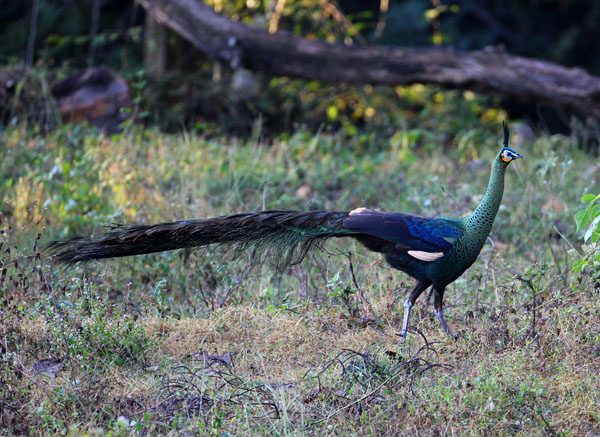Pavo muticus
IUCN
LCBasic Information
Scientific classification
- name:Pavo muticus
- Scientific Name:Green peacock, Java peacock, Vietnamese bird, dragon bird, green peafowl
- Outline:Landfowl
- Family:Galliformes Phasianidae Pavo
Vital signs
- length:180~230 cm
- Weight:7.7 kg
- lifetime:15-20 year
Feature
The peacock is the largest pheasant bird, and the largest male peacock is one of the largest flying birds in existence.
Distribution and Habitat
In China, it is distributed in western and southwestern Yunnan, and may be found in southeastern Tibet. Abroad, it is found in northeastern India, Myanmar, Indochina and Java.
They often live in groups on the edge of forests in riverbanks and villages below 2,000 meters above sea level. They prefer sparse forest edges, clearings between forests or sparse grasslands with many bushes. The male's show-off behavior during courtship is well known. When escaping from natural enemies, they call loudly and flap their wings to fly away quickly.
Appearance
It is large and gorgeous, and the difference between it and the blue peacock distributed abroad is that the neck, chest and flanks are green instead of blue, and the feathers on the top of the head are willow-shaped instead of linear. The iris is reddish brown, the skin around the eyes is blue, the beak is dark brown, and the feet are brown.
Details
The green peacock is a large chicken. The male has emerald blue-green feathers, a cluster of upright crest feathers on the head, and emerald green lower back with a coppery luster. Behind the body is a tail covert that is more than 1 meter long, with shiny and gorgeous eye-shaped spots on the feather tips, forming a gorgeous tail screen, which is very eye-catching. The female bird is not as gorgeous as the male bird, and has no tail screen. The body feathers are mainly emerald metallic green, the back is dark brown, and there is also a cluster of upright crest feathers on the head. The appearance is similar to that of the male bird, which is also very eye-catching. There is no similar species in China, and it is easy to identify in the wild.
The green peacock is a resident bird, often moving in groups, mostly consisting of one male and several females and sub-adults. Sometimes it is seen alone or in pairs. It is good at running, not good at flying. When walking, it is light and agile, and the walking posture is like nodding with every step. When running, it is like running. Generally, when escaping from enemies, it will run fast and flee in the dense forest. It rarely takes off, but it can also fly very fast when gliding downward. It is active during the day, especially in the morning and afternoon. It often climbs trees or rests in the shade of the forest at noon, and roosts on trees at night. It is alert and timid. When it is active, it will look up from time to time to see what is happening around it. When it finds people, it will run away from a distance or flap its wings to fly far away. The call is high and loud, like "ga-wo, ga-wo".

They have a mixed diet, mainly eating plants and crops such as Sichuan pears, yellow pear fruits, young branches and leaves, buds, mushrooms, grass seeds, peas, rice, etc. They also eat grasshoppers, crickets, moths, termites, stink bugs, earthworms, lizards, frogs and other animal food. They often form small groups of 5 to 10 and forage while walking, especially in the early morning and near dusk.
The green peacock is much weaker than the blue peacock in terms of egg production and hatching rate. The female blue peacock lays about 40 eggs a year, and the hatching rate is about 80% under artificial incubation, while the female green peacock lays only about 20 eggs. Even under artificial incubation, a nest of green peacock eggs can only hatch 2 or 3 baby peacocks at most in a year, because the living environment is relatively demanding, and the hatched baby peacocks may not survive.
At the same time, peacocks are the largest pheasant birds, and with their beautiful feathers, they are easily hunted. At the same time, the artificial breeding of green peacocks is not optimistic. Due to the lack of professional wildlife knowledge in the early days, domestic zoos usually raise green peacocks and blue peacocks together, resulting in some green peacock genes being contaminated by blue peacocks. In fact, the green peacocks claimed to be in domestic zoos are basically hybrids of blue and green peacocks, and there are almost no purebred green peacocks. Therefore, the protection of green peacocks is a long way to go.
The green peacock is a native species in my country and the only native peacock. We should not let them disappear from our culture. We also hope that our descendants can still see this beautiful bird. Understanding and paying attention to the green peacock is the beginning of protection.
The first need of life is survival. Every species has the right to guarantee its own survival. For each of us, we should start with ourselves. Respecting life is respecting human beings themselves.








